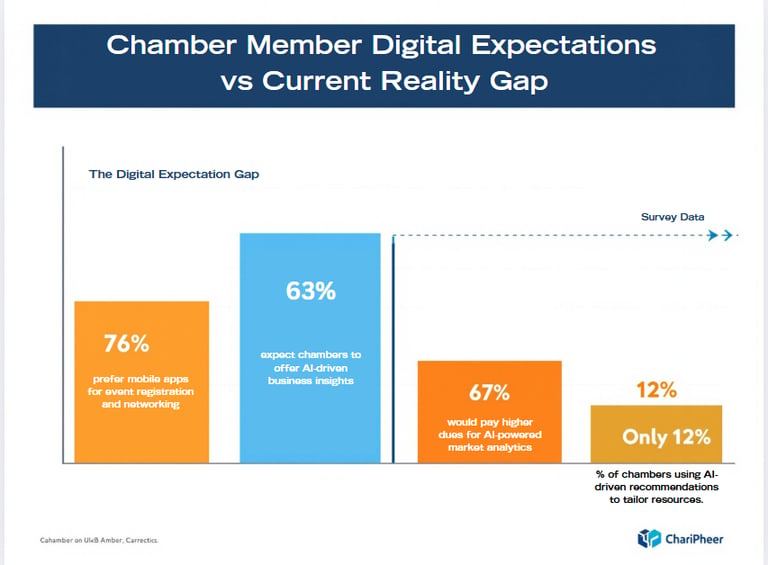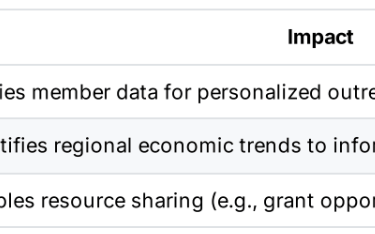Modernizing Chambers of Commerce
Addressing Member Frustrations and Unlocking Growth
An exclusive CXN report exploring why chambers struggle with outdated systems—and how digital modernization can fuel member satisfaction and impact.
Summary
This report dives into member and leader frustrations with legacy chamber systems—including fragmented engagement, paper-heavy processes, and slow responses. Drawing on nationwide surveys and interviews, it delivers a modernization roadmap for chambers to reinvent member experience and unlock sustainable growth.


🕵️♂️Key Findings Highlights
In This Report You’ll Discover:
Why members are disengaged by outdated tools and processes
How disconnected systems lead to inefficiency and frustration
Best practices from modernized chambers embracing digital-first models
Essential features that enhance collaboration, transparency, and engagement
Strategies for modernization tailored to different chamber sizes
Where CXN fits as a connective platform empowering transformation
Gain clarity on the key technical and cultural shifts needed for future-ready chambers.
📊 Key Insights
✅ Member frustration stems from slow, siloed processes
✅ Digital-first chambers lead with integrated tools and real-time updates
✅ CXN facilitates multi-chamber collaboration and member-to-member connections
✅ Analytics and engagement tracking empower data-driven decisions
✅ Modernization unlocks collaboration, innovation, and long-term impact
Author & Publication Details
Produced by the CXN Research Team, this report equips chamber leaders with assessments and recommendations to move beyond outdated systems.
Author: Chamber XChange Network® Research Team
Published: March 2025
Category: Strategic Reports
Transform Your Chamber’s Future Today
Ready to reimagine your chamber strategy? Let’s explore how CXN can help.
Want to reimagine your chamber strategy and engage members more deeply? CXN empowers civic organizations to build engagement-first ecosystems that drive growth and impact.
📖 Full Report: Modernizing Chambers of Commerce
(Read the complete findings directly on this page)
Modernizing Chambers of Commerce | Addressing Member Frustrations & Unlocking Growth
Executive Summary
Chambers of Commerce, long regarded as pillars of local and national business ecosystems, face mounting pressure to modernize. Member frustrations with outdated systems, siloed engagement, and limited digital tools clash with rising expectations for seamless, tech-driven experiences. Meanwhile, budget constraints, legacy infrastructure, and fragmented inter- chamber collaboration stifle innovation. This report examines these challenges, highlights successful modernization efforts, and proposes actionable solutions for chambers to thrive in a digital-first economy.
The Evolving Role of Chambers of Commerce
Historically, chambers served as hubs for networking, advocacy, and business support.
However, the digital age has reshaped member expectations:
Gen Z and Millennial business owners demand instant access to resources, mobile-
friendly platforms, and personalized engagement. [1]
Small businesses increasingly rely on digital tools for marketing, data analytics, and remote
collaboration.[2] [3]
Competition from private-sector platforms (e.g., LinkedIn, Shopify) forces chambers to
differentiate through unique value propositions . [4]
Key Challenges Facing Chambers
Manual processes: Many chambers still rely on paper-based member onboarding, event registration, and dues collection.[2]
Data silos: Disconnected CRM, email, and event management systems hinder personalized member experiences.[3]
Integration bottlenecks: Legacy software often lacks APIs, preventing integration with modern tools like Slack or Zoom.[1]
1. Outdated Systems & Legacy Infrastructure
The Digital Transformation Opportunity
A. Modern Platforms for Collaboration & Data Sharing
B. Value-Added Services for Members
Case Study: The U.S. Chamber of Commerce’s Digital Advocacy Toolkit increased member engagement by 45% by integrating real-time policy updates and automated outreach.[2]
Member Sentiment: The Digital Expectation Gap


Recommended Solutions
Case Studies: Success Stories
1. Austin Chamber of Commerce
Challenge: Declining engagement among young entrepreneurs.
Solution: Launched a mobile app with virtual networking lounges and a “Skills Marketplace” for mentorship.
Result: 33% increase in under-35 membership within 6 months. [1]
2. Denver Metro Chamber
Challenge: Inefficient inter-chamber data sharing.
Solution: Built a regional API ecosystem for real-time labor market analytics.
Result: 20% faster response to workforce development grants.[3]
What Members Are Saying: Feedback from the Field
“Our chamber’s new portal lets me connect with suppliers instantly – it’s like LinkedIn for local businesses.” – Manufacturing CEO, Texas [2]
Conclusion:
Chambers of Commerce must embrace digital transformation to remain relevant. By modernizing infrastructure, fostering inter-chamber collaboration, and aligning with member expectations, they can unlock new growth avenues. Strategic partnerships with tech providers and a relentless focus on user experience will be critical to bridging the innovation gap.
The future of chambers lies not in replacing human connections but in enhancing them through technology.
“Why does event registration still require a PDF form? My generation expects a one-click process.” – E-Commerce Founder, New York [1]
Related Reports
Competitive Market Analysis: Chamber XChange Network vs. Key Competitors →
The Digital Divide in Local Business Support: Why Modern Chambers Must Evolve →




